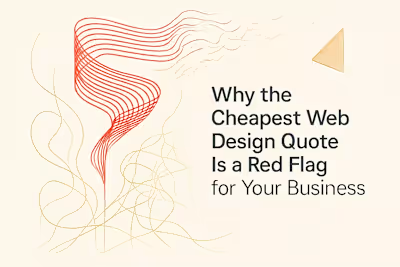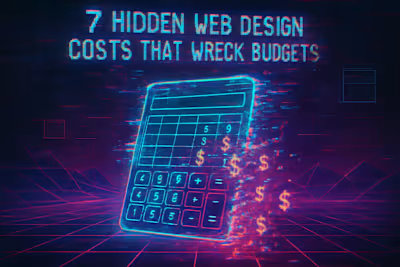Negotiating with Web Designers: A Pro's Guide to Rates and Terms

Negotiating with Web Designers: A Pro's Guide to Rates and Terms
Preparation is Key: Before the Negotiation
Know the Market Rates
Define Your Budget and Priorities
Understand Your Value as a Client
The Negotiation Conversation: Tactics for a Win-Win Outcome
Let the Designer Name Their Price First
Focus on Value, Not Just Price
Negotiate More Than Just Money
Be Willing to Compromise
Finalizing the Agreement
Get Everything in Writing
Know When to Walk Away
References
Negotiating with Web Designers: A Pro's Guide to Rates and Terms
You've compared the proposals and chosen your top candidate. Now it's time to finalize the details. Negotiation isn't about winning or getting the lowest price; it's about reaching a fair agreement that works for both you and the designer, setting the stage for a successful partnership. This guide will help you navigate the conversation around rates and terms.
This step comes after you've learned how to compare proposals fairly. The outcome of your negotiation will be formalized in the project contract, so understanding contracts 101 is your next step. When you're ready to hire web designers, having strong negotiation skills will help you build better partnerships.
Preparation is Key: Before the Negotiation
Entering a negotiation unprepared is a recipe for a poor outcome. This section covers the essential homework you need to do first.
Think of negotiation like preparing for an important meeting. You wouldn't walk into a client presentation without doing your research, right? The same principle applies here. Taking time to prepare gives you confidence and helps you make informed decisions during the actual conversation.
Know the Market Rates
Research the average cost of web design to understand what's fair. Rates can vary widely based on experience, location, and project complexity. A typical range is $75-$150 per hour.
But here's the thing—those numbers are just starting points. A designer in San Francisco might charge $200 per hour, while someone with similar skills in a smaller city might charge $80. Experience matters too. A designer with 10 years under their belt and a portfolio full of Fortune 500 clients will naturally command higher rates than someone just starting out.
Don't just look at hourly rates either. Many designers prefer project-based pricing. A basic five-page website might cost $2,000-$5,000, while a complex e-commerce site could run $10,000-$50,000 or more. The key is understanding what drives these price differences so you can evaluate whether a quote is reasonable for your specific needs.
Define Your Budget and Priorities
Know your absolute maximum budget, but also identify your priorities. Would you rather pay more for a faster timeline or a specific feature? This gives you flexible negotiating points.
Start by setting three budget numbers. First, your ideal budget—what you'd love to pay if everything goes perfectly. Second, your realistic budget—what you expect to pay based on your research. Third, your absolute maximum—the point where you'd need to walk away.
Now think beyond the dollars. What matters most to you? Maybe you need the site launched before a big product release. Or perhaps mobile responsiveness is absolutely critical for your audience. Some clients prioritize having lots of revision rounds, while others want minimal back-and-forth. Knowing these priorities helps you trade off different aspects of the project during negotiation.
Write down your top three must-haves and three nice-to-haves. This list becomes your negotiation roadmap. If the designer's quote is too high, you can discuss removing nice-to-haves rather than compromising on essentials.
Understand Your Value as a Client
Good clients who pay on time, provide clear feedback, and have interesting projects are valuable to freelancers. Highlight these aspects to show you're a great partner to work with.
Freelancers talk to each other. They share horror stories about clients who ghost them, demand endless revisions, or take months to pay invoices. Being known as a good client can actually save you money because designers will want to work with you.
What makes a good client? Pay on time—or even better, pay early. Provide feedback within agreed timelines. Be clear about what you want but also trust the designer's expertise. Have realistic expectations about what's possible within your budget and timeline.
If you have a track record of successful projects, mention it. If you're willing to provide testimonials or referrals, say so. These things have real value to freelancers building their businesses. Sometimes a designer will offer a better rate to a client who's easy to work with and might lead to future opportunities.
The Negotiation Conversation: Tactics for a Win-Win Outcome
This section provides actionable strategies for the negotiation discussion itself, focusing on collaboration rather than confrontation.
Remember, you're not buying a used car here. You're starting a professional relationship that might last weeks or months. The goal isn't to squeeze every penny out of the deal—it's to reach an agreement where both sides feel valued and excited to work together.
Let the Designer Name Their Price First
Asking the freelancer for their rate first gives you a starting point for the discussion. It also shows respect for their expertise.
There's a psychological advantage to letting the other person go first. They might quote lower than you expected, giving you room to add scope. Or if they quote higher, you'll understand their starting position and can work from there.
Try something like: "Based on what we've discussed, what would you charge for this project?" Then—and this is important—stay quiet. Let them answer fully. Many people feel uncomfortable with silence and jump in too quickly, potentially undermining their position.
When they give their number, don't react immediately. Take a moment to consider it. Ask follow-up questions like "What does that include?" or "How did you arrive at that figure?" Understanding their reasoning helps you negotiate more effectively.
Focus on Value, Not Just Price
Instead of trying to haggle the price down, discuss the scope. If the quote is over budget, ask what can be adjusted in the SOW to meet your target price.
This approach respects the designer's expertise while still working toward your budget. Rather than saying "That's too expensive, can you do it for less?" try "That's outside my budget. What could we adjust to bring it down to $X?"
Maybe you can reduce the number of pages, simplify certain features, or handle some tasks yourself. Perhaps the designer quoted for custom illustrations, but you'd be fine with stock images. Or they included three rounds of revisions when you only need two.
The key is maintaining the designer's hourly rate or perceived value while adjusting the amount of work. This shows you respect their worth as a professional. It also leads to better outcomes because the designer won't feel pressured to cut corners or rush through the work.
Negotiate More Than Just Money
If the rate is firm, consider negotiating other terms. This could include payment schedules, the number of revisions, or the project timeline.
Money isn't everything in a freelance agreement. Here are other valuable negotiation points:
Payment terms matter a lot to freelancers. If you can pay 50% upfront instead of the standard 25%, that might be worth a small discount. Or if you can pay the full amount immediately upon completion rather than net-30, mention that.
Timeline flexibility can be valuable too. If the designer can fit your project around other work, they might offer a better rate. Conversely, if you need rush delivery, expect to pay a premium.
Revision rounds are another negotiation point. Maybe the quote includes unlimited revisions, but you're confident you'll only need two. Reducing revision rounds can lower the price while still meeting your needs.
Consider ongoing work too. If this project goes well, will there be maintenance work? Future projects? Freelancers often offer better rates to clients who provide steady work.
Be Willing to Compromise
Negotiation is a two-way street. Be prepared to meet in the middle to create an agreement that feels fair to both sides and fosters a positive working relationship.
The best negotiations end with both parties feeling like they won. This isn't about being soft—it's about being strategic. A designer who feels fairly compensated will do better work and be more invested in your project's success.
Look for creative compromises. Maybe you can't afford the full project now, but you could split it into phases. Design the core pages first, then add the blog section next quarter. This gets you started while respecting both your budget and the designer's rates.
Sometimes compromise means adjusting your expectations. That cutting-edge animation might be amazing, but is it essential? Could you launch with a simpler version and upgrade later? Being flexible on non-essentials often unlocks agreement on the important stuff.
Finalizing the Agreement
Once you've reached a verbal agreement, it's crucial to formalize it to prevent future misunderstandings.
A handshake deal might feel friendly, but it's risky for both sides. Clear documentation protects everyone and actually strengthens the working relationship by setting clear expectations.
Get Everything in Writing
Always follow up the conversation with an email summarizing the agreed-upon terms. This ensures both parties are on the same page before a formal contract is drafted.
Send this email within 24 hours while the conversation is fresh. Include every detail you discussed: the total price, payment schedule, project scope, timeline, revision rounds, and any special terms. Be specific. Instead of "website design," write "5-page website including home, about, services, portfolio, and contact pages with mobile responsive design."
Here's a simple template: "Thanks for our conversation today. To confirm what we discussed: [list all terms]. Please reply to confirm these details are correct, and we can move forward with the formal contract."
This email serves multiple purposes. It prevents misunderstandings, shows professionalism, and creates a paper trail. If there's any confusion about what was agreed, you can reference this email. Many designers will use your summary as the basis for their formal contract, so being thorough here saves time later.
Know When to Walk Away
If you can't reach an agreement that feels fair and respects your budget and the designer's value, it's okay to walk away. A bad deal is worse than no deal.
Sometimes negotiations just don't work out, and that's perfectly fine. Maybe your budget and the designer's rates are too far apart. Perhaps you have fundamentally different visions for the project. Or maybe something just feels off about the interaction.
Red flags include designers who immediately slash their prices by 50% (were they overcharging initially?), those who seem desperate for any work, or anyone who gets defensive or aggressive during negotiations. Trust your instincts here.
Walking away doesn't mean burning bridges. Thank them for their time, explain that it's not the right fit, and leave the door open for future opportunities. The web design community is smaller than you might think, and maintaining professional relationships matters.
Remember, hiring the wrong designer—even at a bargain price—will cost you more in the long run through delays, revisions, and potentially having to hire someone else to fix the work. It's better to wait and find the right match at a fair price than to rush into a bad agreement.
Successful negotiation sets the foundation for a great working relationship. When both parties feel respected and fairly compensated, the project flows more smoothly. The designer brings their best creative energy, you get a website you love, and everyone wins.
Take these negotiation principles and adapt them to your situation. Every project is unique, and flexibility is key. With preparation, respect, and clear communication, you'll reach an agreement that works for everyone involved.
References
Like this project
Posted Jun 30, 2025
Learn how to negotiate web design rates and project terms like a pro. Our guide offers tips on fair pay, contracts, and reaching a win-win agreement with your top candidate.










